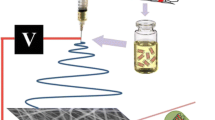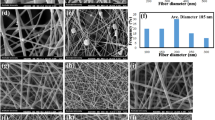Abstract
Photothermal therapy (PTT) has been proposed as an advanced patient-centered strategy for tumor treatment. Nevertheless, the uncertain safety of conventional photothermal conversion agents and the presence of intracellular self-protective autophagy mechanisms pose obstacles to the clinical application and efficacy of PTT. As we are deeply aware of the seriousness of these problems, we herein proposed an efficacy-enhancing strategy based on an implantable membrane platform (PPG@PB-HCQ) constructed from poly (lactic acid) (PLA), poly (ɛ-caprolactone) (PCL) and gelatin (Gel) electrospun nanofibers (PPG) and loaded with the biodegradable high-efficiency photothermal conversion agent Prussian blue (PB) and the autophagy inhibitor hydroxychloroquine sulfate (HCQ). Cellular experiments confirmed that the PPG@PB-HCQ nanofiber membrane exhibited a significantly stronger tumor cell-killing effect compared with the PTT alone. This enhancement features by of blocking the fusion of autophagosomes with lysosomes. The intracellular overexpression of the proteins microtubule-associated protein 1 light chain 3 (LC3)-II and p62 and the low expression of the proteins LC3-I and Rab7 (members of the RAS oncogene family) further demonstrated autophagic flux blockade. Importantly, the potent antitumor effect of the PPG@PB-HCQ therapeutic platform in B16 tumor-bearing model mice verified the efficacy-enhancing strategy of synergistic PTT and protective autophagy blockade. The present study provides a promising strategy for solving the difficulties of tumor treatment, as well as a new perspective for designing novel treatment platforms.
Graphical Abstract









Similar content being viewed by others
Data Availability
Data will be made available on request.
References
Sung H, Ferlay J, Siegel RL, Laversanne M, Soerjomataram I, Jemal A, Bray F. Global cancer statistics 2020: GLOBOCAN estimates of incidence and mortality worldwide for 36 cancers in 185 countries. CA Cancer J Clin. 2021;71:209.
Han HS, Choi KY. Advances in nanomaterial-mediated Photothermal Cancer Therapies: toward clinical applications. Biomedicines. 2021;9:305.
Hong F, Geng X, Min G, Sun X, Zhang B, Yao Y, Li R, Wang J, Zhao H, Guo P, Yuan Z, Wen X, Nie L, Liu G, Chen X, Zhao Q. Deep NIR-II optical imaging combined with minimally invasive interventional photothermal therapy for orthotopic bladder cancer. Chem Eng J. 2022;449:137846.
Yang S-H, Jeong K, Yang J, Son HY, Suh J-S, Huh Y-M, Oh SJ. Non-invasive and depth-free temperature monitoring using MR thermometry in plasmonic photothermal therapy using gold nanorods. Curr Appl Phys. 2023;45:12.
Zou Y, Sun F, Liu C, Yu C, Zhang M, He Q, Xiong Y, Xu Z, Yang S, Liao G. A novel nanotheranostic agent for dual-mode imaging-guided cancer therapy based on europium complexes-grafted-oxidative dopamine. Chem Eng J. 2019;357:237.
Zhang M, Zou Y, Zhong Y, Liao G, Yu C, Xu Z. Polydopamine-based tumor-targeted multifunctional reagents for computer Tomography/Fluorescence Dual-Mode Bioimaging-Guided Photothermal Therapy. ACS Appl Bio Mater. 2019;2:630.
Zou Y, Jin H, Sun F, Dai X, Xu Z, Yang S, Liao G. Design and synthesis of a lead Sulfide Based Nanotheranostic Agent for Computer Tomography/Magnetic Resonance Dual-Mode-Bioimaging-Guided Photothermal Therapy. ACS Appl Nano Mater. 2018;1:2294.
Shao J, Xie H, Wang H, Zhou W, Luo Q, Yu XF, Chu PK. 2D material-based Nanofibrous membrane for Photothermal Cancer Therapy. ACS Appl Mater Interfaces. 2018;10:1155.
Cen D, Wan Z, Fu Y, Pan H, Xu J, Wang Y, Wu Y, Li X, Cai X. Implantable fibrous ‘patch’ enabling preclinical chemo-photothermal tumor therapy. Colloids Surf B Biointerfaces. 2020;192:111005.
Sweeney EE, Cano-Mejia J, Fernandes R. Photothermal Therapy generates a thermal window of immunogenic cell death in Neuroblastoma. Small. 2018;14:1800678.
Yang Y, Faustino PJ, Progar JJ, Brownell CR, Sadrieh N, May JC, Leutzinger E, Place DA, Duffy EP, Yu LX, Khan MA, Lyon RC. Quantitative determination of thallium binding to ferric hexacyanoferrate: prussian blue. Int J Pharm. 2008;353:187.
Li X, Yue X, Wang J, Liang X, Jing L, Lin L, Yang Y, Feng S, Qian Y, Dai Z. Prussian blue nanoparticle-loaded microbubbles for photothermally enhanced gene delivery through ultrasound-targeted microbubble destruction. Sci Bull. 2016;61:148.
Hoffman HA, Chakrabarti L, Dumont MF, Sandler AD, Fernandes R. Prussian blue nanoparticles for laser-induced photothermal therapy of tumors. RSC Adv. 2014;4:29729.
Melamed JR, Edelstein RS, Day ES. Elucidating the fundamental mechanisms of cell death triggered by Photothermal Therapy. ACS Nano. 2015;9:6.
Gadeval A, Chaudhari S, Bollampally SP, Polaka S, Kalyane D, Sengupta P, Kalia K, Tekade RK. Integrated nanomaterials for non-invasive photothermal therapy of rheumatoid arthritis. Drug Discov Today. 2021;26:2315.
Ren Y, Yan Y, Qi H. Photothermal conversion and transfer in photothermal therapy: from macroscale to nanoscale. Adv Colloid Interface Sci. 2022;308:102753.
Zhang Y, Zhan X, Xiong J, Peng S, Huang W, Joshi R, Cai Y, Liu Y, Li R, Yuan K, Zhou N, Min W. Temperature-dependent cell death patterns induced by functionalized gold nanoparticle photothermal therapy in melanoma cells. Sci Rep. 2018;8:8720.
Chen L, Sun X, Cheng K, Topham PD, Xu M, Jia Y, Dong D, Wang S, Liu Y, Wang L, Yu Q. Temperature-regulating Phase Change Fiber Scaffold toward mild photothermal-chemotherapy. Adv Fiber Mater. 2022;4:1669.
Hildebrandt B, Wust P, Ahlers O, Dieing A, Sreenivasa G, Kerner T, Felix R, Riess H. The cellular and molecular basis of hyperthermia. Crit Rev Oncol Hematol. 2002;43:33.
Ali MR, Rahman MA, Wu Y, Han T, Peng X, Mackey MA, Wang D, Shin HJ, Chen ZG, Xiao H, Wu R, Tang Y, Shin DM, El-Sayed MA. Efficacy, long-term toxicity, and mechanistic studies of gold nanorods photothermal therapy of cancer in xenograft mice. Proc Natl Acad Sci. 2017;114:E3110.
Vilches C, Quidant R. Frontiers of nanoscience. In: Wolfgang J, Parak, Neus, Feliu, editors. Targeted hyperthermia with plasmonic nanoparticles. Colloids for nanobiotechnology-synthesis, characterization and potential applications. Amsterdam: Elsevier; 2020. p. 307.
Ghomi ER, Lakshminarayanan R, Chellappan V, Verma NK, Chinnappan A, Neisiany RE, Amuthavalli K, Poh ZS, Wong BHS, Dubey N, Narayan R, Ramakrishna S. Electrospun Aligned PCL/Gelatin Scaffolds mimicking the skin ECM for effective antimicrobial wound dressings. Adv Fiber Mater. 2023;5:235.
Wang Z, Hu W, Wang W, Xiao Y, Chen Y, Wang X. Antibacterial electrospun nanofibrous materials for wound healing. Adv Fiber Mater. 2023;5:107.
Chen Y, Dong X, Shafiq M, Myles G, Radacsi N, Mo X. Recent advancements on three-dimensional electrospun nanofiber scaffolds for tissue engineering. Adv Fiber Mater. 2022;4:959.
da Silva D, Kaduri M, Poley M, Adir O, Krinsky N, Shainsky-Roitman J, Schroeder A. Biocompatibility, biodegradation and excretion of polylactic acid (PLA) in medical implants and theranostic systems. Chem Eng J. 2018;340:9.
Zhou Z, Yan Y, Hu K, Zou Y, Li Y, Ma R, Zhang Q, Cheng Y. Autophagy inhibition enabled efficient photothermal therapy at a mild temperature. Biomaterials. 2017;141:116.
Gao G, Sun X, Liu X, Jiang YW, Tang R, Guo Y, Wu FG, Liang G. Intracellular nanoparticle formation and hydroxychloroquine release for autophagy-inhibited mild‐temperature photothermal therapy for tumors. Adv Funct Mater. 2021;31:2102832.
Mizushima N, Levine B, Cuervo AM, Klionsky DJ. Autophagy fights disease through cellular self-digestion. Nature. 2008;451:1069.
Chen T, Cen D, Ren Z, Wang Y, Cai X, Huang J, Di Silvio L, Li X, Han G. Bismuth embedded silica nanoparticles loaded with autophagy suppressant to promote photothermal therapy. Biomaterials. 2019;221:119419.
Zhao YG, Codogno P, Zhang H. Machinery, regulation and pathophysiological implications of autophagosome maturation. Nat Rev Mol Cell Biol. 2021;22:733.
Hyttinen JM, Niittykoski M, Salminen A, Kaarniranta K. Maturation of autophagosomes and endosomes: a key role for Rab7. Biochim Biophys Acta. 2013;1833:503.
Ferreira PMP, Sousa RWR, Ferreira JRO, Militao GCG, Bezerra DP. Chloroquine and hydroxychloroquine in antitumor therapies based on autophagy-related mechanisms. Pharmacol Res. 2021;168:105582.
Li Y, Cho MH, Lee SS, Lee DE, Cheong H, Choi Y. Hydroxychloroquine-loaded hollow mesoporous silica nanoparticles for enhanced autophagy inhibition and radiation therapy. J Control Release. 2020;325:100.
Levy JMM, Towers CG, Thorburn A. Targeting autophagy in cancer. Nat Rev Cancer. 2017;17:528.
Maclean KH, Dorsey FC, Cleveland JL, Kastan MB. Targeting lysosomal degradation induces p53-dependent cell death and prevents cancer in mouse models of lymphomagenesis. J Clin Invest. 2008;118:79.
Lian H, Guan P, Tan H, Zhang X, Meng Z. Near-infrared light triggered multi-hit therapeutic nanosystem for tumor specific photothermal effect amplified signal pathway regulation and ferroptosis. Bioact Mater. 2022;9:63.
Zhong Y, Zou Y, Liu L, Li R, Xue F, Yi T. pH-responsive ag(2)S nanodots loaded with heat shock protein 70 inhibitor for photoacoustic imaging-guided photothermal cancer therapy. Acta Biomater. 2020;115:358.
Rwei AY, Lee JJ, Zhan C, Liu Q, Ok MT, Shankarappa SA, Langer R, Kohane DS. Repeatable and adjustable on-demand sciatic nerve block with phototriggerable liposomes. Proc Natl Acad Sci USA. 2015;112:15719.
Wang L, Li B, Xu F, Xu Z, Wei D, Feng Y, Wang Y, Jia D, Zhou Y. UV-crosslinkable and thermo-responsive chitosan hybrid hydrogel for NIR-triggered localized on-demand drug delivery. Carbohydr Polym. 2017;174:904.
Kassis S, Grondin M, Averill-Bates DA. Heat shock increases levels of reactive oxygen species, autophagy and apoptosis. Biochim Biophys Acta Mol Cell Res. 2021;1868:118924.
Li H, Liu Y, Wen M, Zhao F, Zhao Z, Liu Y, Lin X, Wang L. Hydroxysafflor yellow A (HSYA) alleviates apoptosis and autophagy of neural stem cells induced by heat stress via p38 MAPK/MK2/Hsp27-78 signaling pathway. Biomed Pharmacother. 2019;114:108815.
Huang R, Liu W. Identifying an essential role of nuclear LC3 for autophagy. Autophagy. 2015;11:852.
Wang W, Li W, Li J, Li L, Tang X, Zhang M. Peroxiredoxin 1 inhibits autophagy through interacting with Rab7 in human dysplastic oral keratinocyte cells. Arch Oral Biol. 2022;141:105491.
Islam MA, Sooro MA, Zhang P. Autophagic regulation of p62 is critical for cancer therapy. Int J Mol Sci. 2018;19:1405.
Liu WJ, Ye L, Huang WF, Guo LJ, Xu ZG, Wu HL, Yang C, Liu HF. p62 links the autophagy pathway and the ubiqutin-proteasome system upon ubiquitinated protein degradation. Cell Mol Biol Lett. 2016;21:29.
Ren X, Chen Y, Peng H, Fang X, Zhang X, Chen Q, Wang X, Yang W, Sha X. Blocking autophagic flux enhances iron oxide nanoparticle photothermal therapeutic efficiency in cancer treatment. ACS Appl Mat Interfaces. 2018;10:27701.
Gutierrez MG, Munafo DB, Beron W, Colombo MI. Rab7 is required for the normal progression of the autophagic pathway in mammalian cells. J Cell Sci. 2004;117:2687.
Acknowledgements
This work was supported by the Scientific Research Projects of Liaoning Provincial Department of Education (Grant No: LJKMZ20221354), Natural Science Foundation of Liaoning Province (Grant No: 2023-MS-198), Cultivation Fund Project of National Natural Science Foundation (Grant No: PYJJ2021101) and Career Development Support Program for Young and Middle-aged Teachers (Grant No: ZQN202208) of Shenyang Pharmaceutical University. The authors would like to thank the Shiyanjia lab (www.Shiyanjia.com) for the SEM, DSC and XRD tests.
Author information
Authors and Affiliations
Corresponding author
Ethics declarations
Conflict of interest
The authors declare that they have no known competing financial interests or personal relationships that could have appeared to influence the work reported in this paper.
Additional information
Publisher’s Note
Springer Nature remains neutral with regard to jurisdictional claims in published maps and institutional affiliations.
Supplementary Information
Below is the link to the electronic supplementary material.
Rights and permissions
Springer Nature or its licensor (e.g. a society or other partner) holds exclusive rights to this article under a publishing agreement with the author(s) or other rightsholder(s); author self-archiving of the accepted manuscript version of this article is solely governed by the terms of such publishing agreement and applicable law.
About this article
Cite this article
Mu, J., Meng, Z., Liu, X. et al. Implantable Nanofiber Membranes with Synergistic Photothermal and Autophagy Inhibition Effects for Enhanced Tumor Therapy Efficacy. Adv. Fiber Mater. 5, 1810–1825 (2023). https://doi.org/10.1007/s42765-023-00311-6
Received:
Accepted:
Published:
Issue Date:
DOI: https://doi.org/10.1007/s42765-023-00311-6




